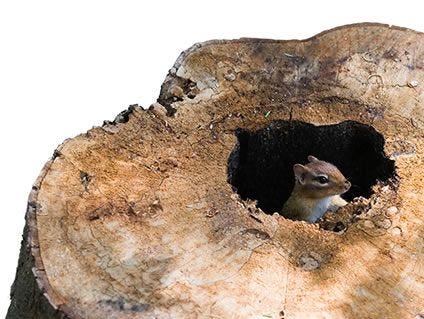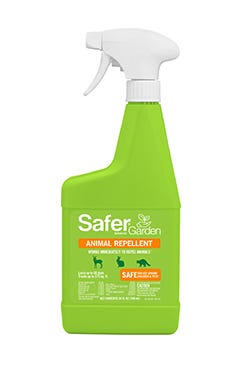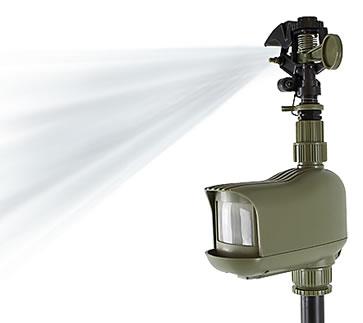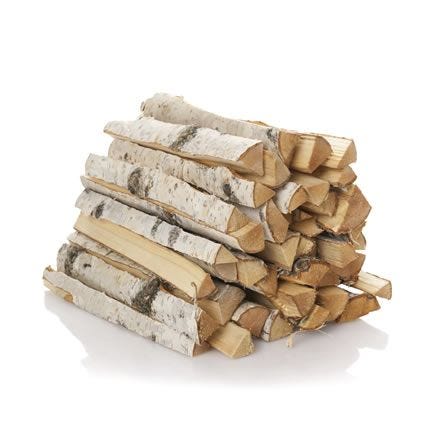





Chipmunks
How to Repel Chipmunks
Successfully repelling chipmunks and keeping them away requires an effective repelling plan. Below, Havahart® provides step-by-step instructions teaching you how to use repellents and how to keep chipmunks out of your home or yard.
1 Identify Patterns of Activity

Knowing where your chipmunks are spending most of their time and identifying their damage will help you choose the best repelling solution.
Common chipmunk activities include:
- gnawing wood in your attic
- eating holes in your plants
- digging up bulbs or seedlings
- knocking over bird feeders
- living under home foundations
- burrowing under lawns or structures
2 Choose the Best Chipmunk Repellent
Once you've identified an area of damage, use the information below to choose the repellent that best fits your needs. When using repellents for heavy chipmunk infestations, it's important to employ multiple methods to give you the best chance of getting rid of chipmunks long-term.
Liquid Spray Repellents

Best For: Protecting outdoor surfaces against chipmunks. Directly apply to objects that chipmunks commonly eat or invade, such as:
- bird feeders
- plants and trees
- bulbs
- roofing/gutters
- flowers/flowerbeds
- wood piles or mulch
TIP: Safer® Garden Animal Repellent Spray works best in temperatures above 40°F and should be applied until the surface is drenched and liquid is running off. Repellent reapplication is critical, especially after heavy rainfall or new plant growth.
Shop Liquid Repellents »Granular Repellents
Best For: Creating a repellent barrier around indoor or outdoor areas where chipmunks travel or take shelter, such as:

- attics
- crawl spaces
- gardens
- flowerbeds
- mulch beds
- pathways
- brush covering
- house perimeters
TIP: Safer® Brand Critter Ridder® Animal Repellent works best when applied to level surfaces. They can be used in any climate and tend to last longer than liquids. Granules are great for excluding chipmunks from burrowing underneath homes and damaging foundations. Simply sprinkle the granules around the outside walls to prevent digging.
Shop Granular Repellents »Electronic Repellents
Best For: Frightening persistent chipmunks with sudden bursts of water to condition them to stay away from virtually any area, such as:

- vegetable gardens
- plants
- mulch beds
- pathways
- flowerbeds
- pool areas
- yards/lawns
- structures
- koi ponds
- property entryways
- garbage cans
- trees
TIP: Electronic repellents, like our Critter Ridder® Motion-Activated Animal Repellent & Sprinkler, continue to grow in popularity as they are great solutions for controlling a wide variety of animals and have the ability to be placed anywhere in the yard. However, electronics rely on sight to activate. Therefore, dialing in the right setting is key to seeing small animals like chipmunks. Electronics alone are not recommended to obtain complete chipmunk control but they are great additions to a regimen using liquid or granular repellents.
Shop Electronic Repellents »3 Apply as Directed

Animal repellents are only effective if the user thoroughly understands and follows the directions for use. Below are critical points to keep in mind when using repellents:
- Reapplication is necessary to maintain full repellency.TIP: Use a calendar to maintain a regular application schedule.
- Shake liquids vigorously before use to ensure proper mixing of active ingredients and to prevent clogging.
- Spray leaves generously, until runoff occurs. Concentrates and pump sprayers are best for large applications.
- Setup is crucial to the success of electronic repellents. To sense animals like chipmunks, the detection system should be set to the highest sensitivity, and the sensor should be aimed in the direction chipmunks are approaching.
4 Reduce Attractants

Removing sources of food, water and shelter will help to deter future chipmunks and should be part of an integrated control plan. Take steps to make your yard less attractive to chipmunks by:
- cleaning up leftover food/pet food
- clearing fallen berries, nuts, birdseed, etc.
- removing birdbaths and other sources of water
- clearing wood or brush piles where chipmunks may take cover, especially those adjacent to your home
- sealing off any possible entryways or cracks in your home's foundation
- placing bird feeders at 15-30 feet from structures so spilled seed doesn't lure in chipmunks
TIP: Replace your birdseed with a kind chipmunks aren’t fond of, such as thistle.
Expert Tips
- With chipmunks constantly preening, a repellent that works as a taste deterrent will be most effective. Look for repellents with pepper-based ingredients that are proven to deter chipmunks in this way.
- Be patient! Although liquid and granular repellents are effective immediately, it may take several interactions with the repellent for the animal to associate the unpleasant scent and irritation with the repellent - and ultimately with the protection area. Successfully repelling an animal relies heavily on the animal's interaction with the repellent. In some cases, more repellent may be needed OR some may need to be applied in a different location to gain the interaction that will ultimately repel the animal.
- Liquid repellent concentrates are great for protecting bulbs from chipmunks - simply dip the bulbs into the concentrated solution before planting.
- Chipmunks commonly cause damage to homes and their foundations. Landscaping should not be planted continuously against your house as it provides ample ground cover near your home's foundation. As a further preventative step, apply mesh or caulking in foundation openings to ensure that chipmunks stay out.
